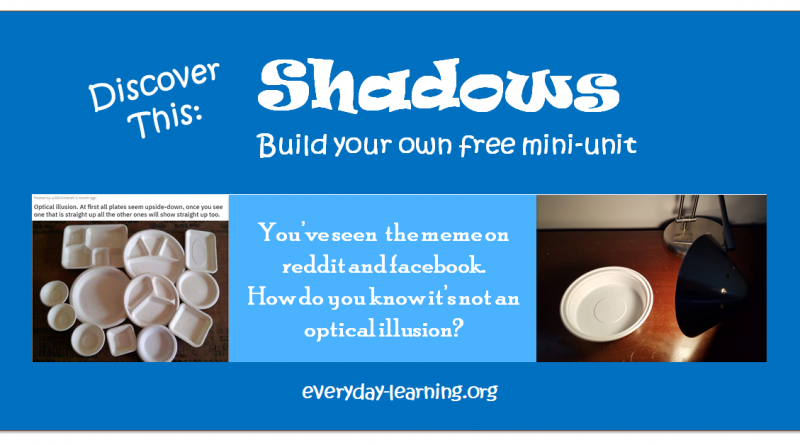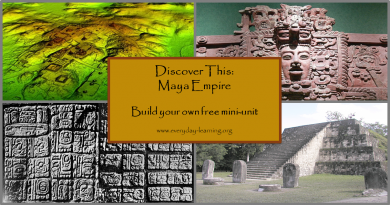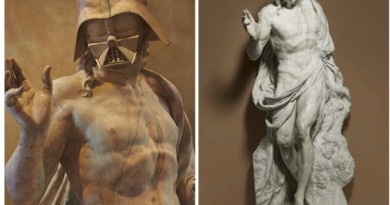Discover This: Shadows

You’ve probably seen the picture meme floating around social media at the end of 2018. It’s a bunch of plastic plates and bowls and the challenge is to figure which single item is right-side up. If you are clever enough to see through the optical illusion, so the meme suggests, then suddenly all the plates will magically show as right-side up.
Usually, I see this kind of thing and keep scrolling by, but I started noticing how some friends were sharing the picture. Some would say, “Is it me? I can’t find the plate that isn’t upside down.”
Other people would post proud statements of, “OMG! This is amazing! The plates flipped when I looked at the picture.”
All I kept thinking was: Shadows don’t lie.
A lot of math and science co-exist with shadows. They can help us observe the earth’s movement around the sun. They can be used to tell time. Shadows can also help with direction. Knowing that the sun rises in the east and sets in the west means that observing the movement of the sun through the shadows it makes can give a person a hint about the direction they’re heading in.
Shadows – along with some trigonometry – can also help to determine the depth of a crater. In the case of the plate-flipping picture meme, the “crater” is just the base of the bowl where the food sits.
Before we talk about this more, check out this 5-minute Crash Course video for kids. It’s geared for 4th – 6th graders.
Got younger kiddos? Take a look at this video, instead.
So, yeah, that plate-flipping picture meme. I guess it’s time we teach about shadows. Setting up a simple experiment at home can help shed some light (yeah, I went there) on whether the meme is a real optical illusion OR just a joke. The experiment requires either a lamp or a flashlight and some type of bowl.
Start by placing the bowl right-side up, like you’re getting ready to put something inside of it. Shine the light on the bowl from different directions. Describe the shadows you see. Can you describe any other light effects that you see?
Next, turn the bowl upside down. The bowl looks more like a plateau than a crater, right? Repeat the process by shining a light on the bowl. Do you see any shadows this time? Do you see shiny spots on the bowl, instead? Describe the different light effects you see when the bowl is right-side up versus upside down.

Finally, compare and contrast what you’ve discovered with the original picture meme. Using critical thinking, answer the question: Are any of the plates and bowls upside down to begin with?
Teach About Shadows and Light With 7 Learning Activities
You can keep learning about shadows for days, using any of the following free ideas.
- Transparent, Translucent, and Opaque Scavenger Hunt
Introduce kids to key vocabulary: Transparent (clear, like glass); Translucent (semi-see through, like wax paper); and Opaque (solid, like a ceramic plate). Explore how much – if at all – you can see through different objects and classify them according to your new vocabulary. Give the kids a clipboard and have them come back with a list of at least 5 items they find in the house for each category. You can even place different objects in direct sunlight and have your child observe the differences in shadows each object makes.
- Experiment With Shadows
Grab a couple of flashlights and start experimenting with light and shadows. Pick a scientific question, like: Will a shadow be longer or shorter the closer the light source is to an object? Or, what will the shadow look like when light sources are coming from different directions? Next, have everyone hypothesize an answer. Finally, carry out the light-shadow test, record your findings, and talk about why you were surprised by what you saw.
Sign-up for More Free Everyday Learning Ideas
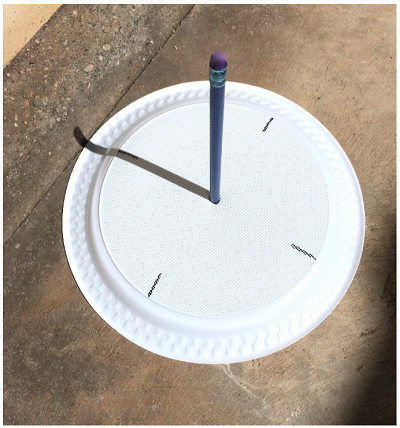
- Make a Sundial
Spend some time looking at some images of sundials from Ancient Babylonia, Greece, and Rome. Based on what you’ve already explored with light and shadows, ask your child to explain how they worked. Try making your own sundial using a disposable plate and a pencil and then discuss similarities with analog clocks. If you’re feeling particularly ambitious, check out this great sundial activity that includes a bunch of math connections.
- Orienteering and Cardinal Directions
If you’ve never learned about cardinal directions (aka North-South-East-West), this is a great time to start. You can begin with the obvious connection of how the sun rises from the east and sets in the west. Once you master the basics, introduce how to use a compass before learning how to use sun shadows to keep from getting lost in the woods.
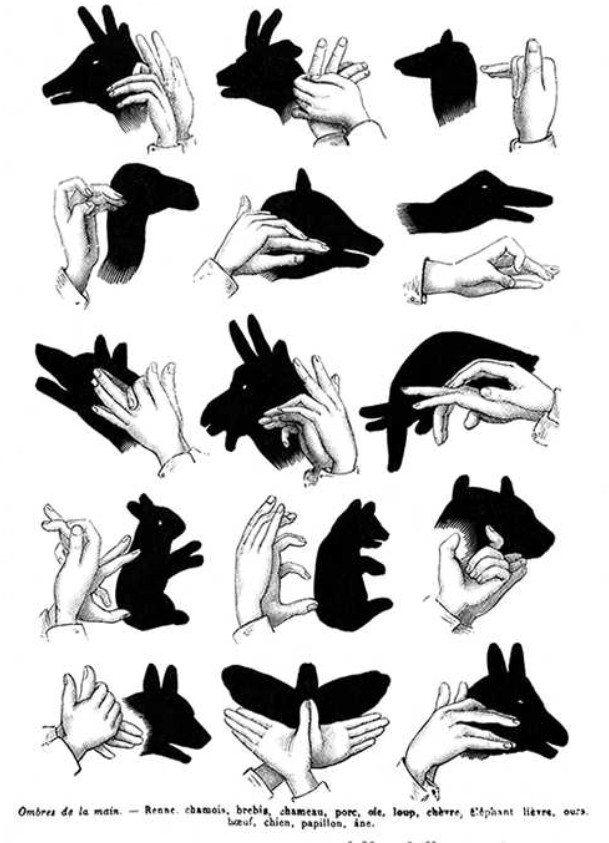
- Make Hand Shadows
This is the perfect rainy day / too cold to go outside day / or stop climbing up the wall day activity. All you need is a bare lightbulb and a blank wall and a challenge to see how many animals you can make with your hands.
- Create a Shadow Puppet Theater
Shadow puppet theater is a 2,000+ year old Asian art form. The idea is simple: Cut out basic shapes of people, animals, and settings (like a tree or a building) out of thin cardboard, such as an old cereal box. Tape the shape to a pencil, drinking straw, or craft stick. Create a shadow stage (see how one mom made one out of a cereal box and copy paper). Kids can put on a show by putting their shadow puppets between the light and their shadow stage. Experiment with the size of shadows by moving the puppets closer to the light then further away again. Oh, and be sure to record the puppet show with your camera phone so your kids can see themselves perform.
Make it personal
- In the book (as well as the Disney movie), Peter Pan loses his shadow and Wendy “locks it up” so the shadow can’t get into trouble. Sure the story is make-believe, but oh, the conversations you can have about that!
- Shadows are always there. Wherever you go, they go with you. Can you think of anything/anyone else who is always with you?
- Some kids are afraid of shadows in the night (or in the basement). Talk about what those shadows represent – both for real and within your kiddo’s imagination. Can you use your new shadow knowledge to be more brave?
Australian teacher, Loren T., contributed to the Discover This: Shadows post. Visit Loren’s blog at www.mrstmusings.wordpress.com.

